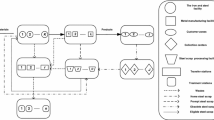Abstract
The problem of the distribution center is concerned with how to select distribution centers from a potential set in order to minimize the total relevant cost comprising of fixed costs of the distribution center and transport costs, and minimize the transportation time. In this paper, we propose a multi-objective network optimal model with random fuzzy coefficients for the logistics distribution center location problem. Furthermore, we convert the uncertain model into a deterministic one by the probability and possibility measure. Then the spanning tree-based genetic algorithm (st-GA) by the Prüfer number representation is introduced to solve the crisp multiobjective programming. At last, the proposed model and algorithm are applied to the Xinxi Dairy Holdings Limited Company to show the efficiency.
Similar content being viewed by others
References
Barahona F., Jensen D. (1998) Plant location with minimum inventory. Mathematical Programming 83: 101–111
Buckley, J. J. (2006). Fuzzy Probability and Statistics. StudFuzz 196.
Chankong V., Haimes Y.Y. (1983) Multiobjective decision making: Theory and methodology. North-Holland, Amsterdam
Charnes A., Cooper W. W. (1963) Deterministic equivalents for optimizing and satisficing under chance constraints. Operational Research 11: 18–39
Chen C. (2001) A fuzzy approach to select the location of the distribution center. Fuzzy Sets and Systems 118: 65–73
Davis M. M., Maggard M. J. (1990) An analysis of customer satisfaction with waiting times in a two-stage service process. Journal of Operations Management 9(3): 324–334
Dubois D., Prade H. (1978) Operations on fuzzy numbers. International Journal of System Sciences 9: 613–626
Dubois D., Prade H. (1980) Fuzzy sets and systems: Theory and applications. Academic Press, New York
Gen M., Cheng R. (2000) Genetic algorithms and engineering optimization. Wiley, New York
Harkness J. (2003) Facility location with increasing production costs. Operational Research 145: 1–13
Itoh T., Ishii H. (2005) One machine scheduling problem with fuzzy random due-dates. Fuzzy Optimization and Decision Making 4: 71–78
Karabuk S. (2007) Modeling and optimizing transportation decisions in a manufacturing supply chain. Transportation Research Part E 43: 321–337
Klement, E. P., Puri, M. L., Ralescu, D. A. (1986). Limit theorems for fuzzy random variables. Proceedings of the Royal Society of Lodon A 407, pp. 171–182
Kwakemaak H. (1978) Fuzzy random variables-I. Definitions and theorems. Information Sciences 15(1): 1–29
Klose A., Drexl A. (2005) Facility location models for distribution system design. Operational Research 102: 4–29
Li J., Xu J., Gen M. (2006) A class of multiobjective linear programming model with fuzzy random coefficients. Mathematical and Computer Modelling 44: 1097–1113
Liu B. (2002) Theory and practice of uncertain programming. Physica-berlag, New York
Lodwick W., Bachman K. (2005) Solving large-scale fuzzy and possibilistic optimization problems. Fuzzy Optimization and Decision Making 4: 257–278
Michalewicz Z. (1994) Genetic algorithms + data structures = Evolution programs, 2nd edn. Springer, New York
Mittal V., Kamakura W. A. (2001) Satisfaction, repurchase intent, and repurchase behavior: Investigation the moderating effect of customer characteristics. Journal of Marketing Research 38: 131–142
Moreno J., Moreno-Vega J., Verdegay J. (2004) Fuzzy location problems on networks. Fuzzy Sets and Systems 142: 393–405
Nahmias S. (1979) Fuzzy variables. Fuzzy Sets and Systems 1: 97–110
Näther W. (2000) On random fuzzy variables of second order and their application to linear statistical inference with fuzzy data. Metrika 51: 201–221
Okada S., Soper T. (2000) A shortest path problem on a network with fuzzy arc lengths. Fuzzy Sets and Systems 109: 129–140
Puri M. L., Ralescu D. A. (1986) Fuzzy random variables. Journal of Mathematical Analysis and Applications 114: 409–422
Shen Q., Zhao R., Tang W. (2009) Random fuzzy alternating renewal processes. Soft Computing 13: 139–147
Sheu J. (2004) A hybrid fuzzy-based approach for identifying global logistics strategies. Transportation Research Part E 40: 39–61
Stalk G. Jr (1988) Time-The next source of competitive advantage. Harvard Business Review 66(4): 41–51
Syam S. (2002) A model and methodologies for the location problem with logistical components. Comput. Oper. Res. 29: 1173–1193
Syarif A., Yun Y. S., Gen M. (2002) Study on multi-stage logistic chain network: A spanning tree-based genetic algorithm approach. Computer and Industrial Engineering 43: 299–314
Tan M., Tang X. (2006) The further study of safety stock under uncertain environment. Fuzzy Optimization and Decision Making 5: 193–202
Tragantalerngsak S., Holt J., Ronnqvist M. (2000) An exact method for the two-echelon, single-source, capacitated facility location problem. Operational Research 123: 473–489
Wang X., Tang W., Zhao R. (2007) Random fuzzy EOQ model with imperfect quality items. Fuzzy Optimization and Decision Making 6: 139–153
Xu J., Liu Q., Wang R. (2008) A class of multi-objective supply chain networks optimal model under random fuzzy environment and its application to the industry of Chinese liquor. Information Sciences 178: 2022–2043
Yang L. et al (2007) Logistics distribution centers location problem and algorithm under fuzzy environment. Computational and applied mathematics 208: 303–315
Zadeh L. (1965) Fuzzy sets. Information and Control 8: 338–353
Zadeh L. (1978) Fuzzy sets as a basis for a theory of possibility. Fuzzy Sets and Systems 1: 3–28
Zhou G., Min H., Gen M. (2002) The balanced allocation of customers to multiple distribution centers in the supply chain network: A genetic algorithm approach. Computational and Industrial Engineering 43: 251–261
Author information
Authors and Affiliations
Corresponding author
Rights and permissions
About this article
Cite this article
Xu, J., Yao, L. & Zhao, X. A multi-objective chance-constrained network optimal model with random fuzzy coefficients and its application to logistics distribution center location problem. Fuzzy Optim Decis Making 10, 255–285 (2011). https://doi.org/10.1007/s10700-011-9105-6
Published:
Issue Date:
DOI: https://doi.org/10.1007/s10700-011-9105-6




